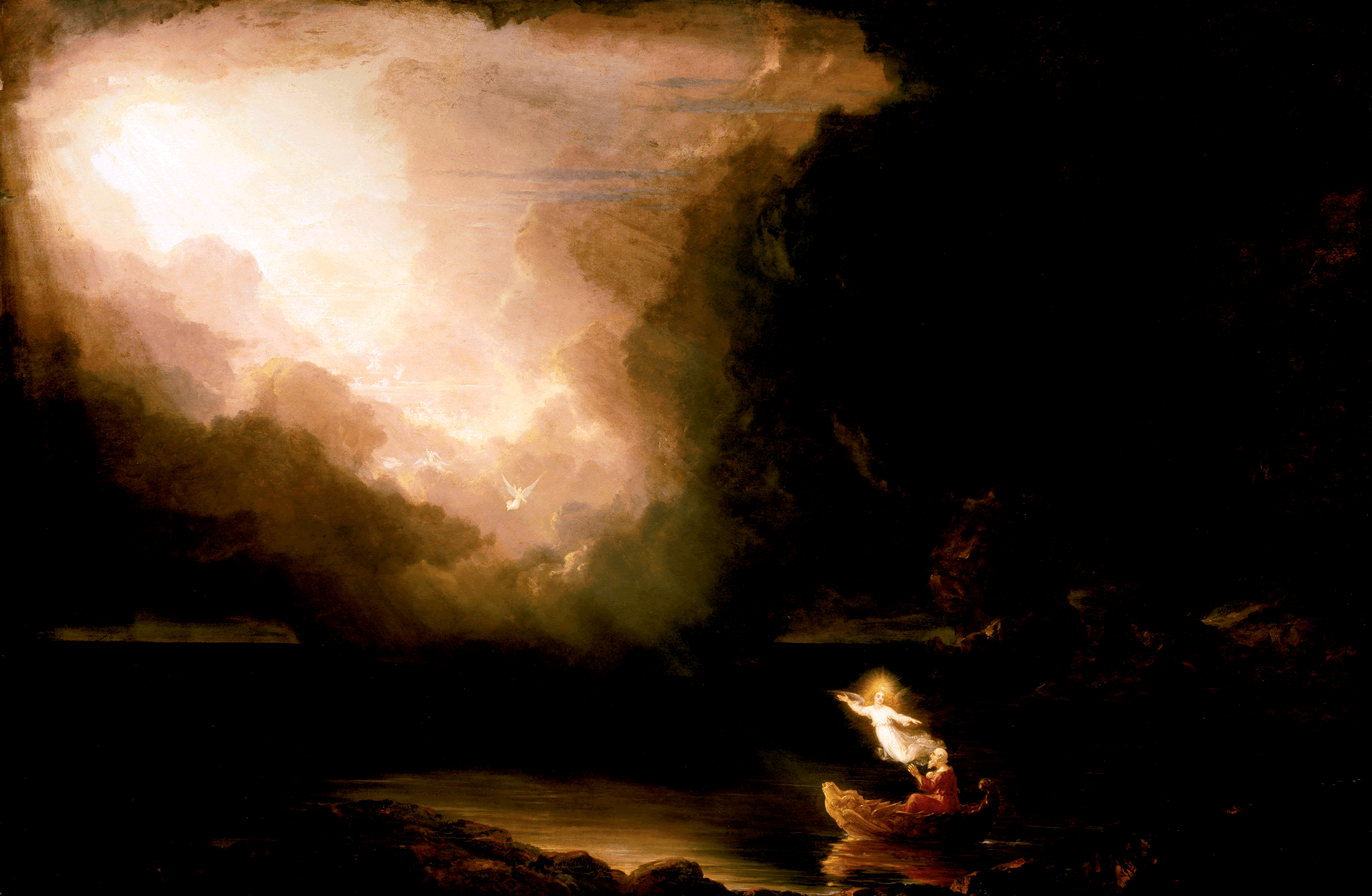The Voyage of Life: Old Age (First Set)

About
Decode
Compare
Cole's Process
Cole's Words
Locate
About
OLD AGE.—Portentous clouds are brooding over a vast and midnight Ocean. A few barren rocks are seen through the gloom—the last shores of the world. These form the mouth of the river; and the Boat, shattered by storms, its figures of the Hours broken and drooping, is seen gliding over the deep waters. Directed by the Guardian Spirit, who thus far has accompanied him unseen, the Voyager, now an old man, looks upward to an opening in the clouds, from whence a glorious light bursts forth; and angels are seen descending the cloudy steps, as if to welcome him to the Haven of Immortal Life.
The stream of life has now reached the Ocean, to which all life is tending. The world, to Old Age, is destitute of interest. There is no longer any green thing upon it. The broken and drooping figures on the Boat show that time is nearly ended. The chains of corporeal existence are falling away; and already the mind has glimpses of Immortal Life. The angelic Being, of whose presence, until now, the Voyager has been unconscious, is revealed to him; and, with a countenance beaming with joy, shows to his wondering gaze scenes such as the eye of mortal man has never beheld. 1
Decode
Mouse over the detail to view its caption, click it to zoom in, and use the reset button on the lower right to zoom back out.
1. The Voyager sits in the boat, as he did in childhood. He is now an old man. He floats from the river into the "Ocean of Eternity." The sculpted figures on the boat also droop with old age.
2. The angel rejoins the Voyager at the end of his days to lead him to heaven.
3. The hourglass has completely broken off the boat: the Voyager's time is up.
4. Light from the heavens shines onto the Voyager, signifying his salvation.
5. An angel descends from Heaven, while others wait in the clouds, "as if to welcome him to the Haven of Immortal Life."
6. The lack of trees or vegetation signifies that it is winter, the end of the year. The barren rocks are "the last shores of the world."
7. The dark clouds confirm the end of day, and the end of the Voyager's life.
Compare
Thomas Cole, Pilgrim of the Cross, oil on canvas, c.1846-47, 12 x 18 in. Smithsonian American Art Museum. Museum purchase, 1965.10. View in Virtual Gallery
Cole began attending St. Luke's Episcopal Church in Catskill after his marriage to Maria Bartow in 1836, and this event marked a turning point in his religious life. At this time he began sketching ideas for The Voyage of Life. In 1844, the Reverend Louis Legrand Noble baptized his good friend Cole, signifying the artist's official acceptance of the Church and his commitment to Christianity. Soon thereafter, Cole began work on his last major allegorical series, The Cross and the World, left unfinished due to his untimely death in 1848. Noblesaid of the series, "While it reflects the religion of the Incarnate Son, it is also a reflection of himself—of Cole, the Christian, including all his past and future Christian experience." 1 In The Cross and the World, Cole explored themes similar to those in The Voyage of Life—a pilgrim makes a spiritual journey in which he has to choose between God (the Cross) and sin and temptation (the World). Compositionally, the two paintings are very similar. In The Pilgrim of the Cross, Cole makes his message even more explicit by including a cross made of light in the clouds, a sign of redemption for the weary traveler. 2
Process
Comparing this early preliminary oil sketch with the finished work demonstrates how Cole experimented with different ideas for composition, figure placement, and tonal contrasts. The sketch dates from the time when Cole still conceived of the river flowing in the same direction from canvas to canvas, an idea he subsequently abandoned when he realized that given the space in Ward'sgallery, the works would be displayed in pairs on opposite walls. Other differences in the oil study include a more distanced spatial relationship of the Guardian Spirit to the Voyager, and a more ominous sky, with only a small opening for the soul's ascension to heaven.
Works
1. Thomas Cole, Study for the Voyage of Life: Old Age, oil on wooden panel, c. 1837-39, 12 x 13 11/16 in. Albany Institute of History and Art. View in Virtual Gallery
2. Thomas Cole, The Voyage of Life: Old Age (First Set), oil on canvas, 1840, 51 ¾ x 78 ¼ in. Munson-Williams-Proctor Arts Institute, Utica, NY, 55.108.
Words
The wings of Time are heavier & heavier laden as he flies; each hour brings its own trouble without dissipating that of the past. This reconciles us to death; when the soul is fatigued rest is welcome. 'O that I had the wings of a dove, then would fly away & be at rest.' Although pain & trouble may accumulate as we pass through life[,] hope like a star lights our path & as the darkness deepens increases in brightness[,] for as through reason of the darkness we perceive not the earth around us but look towards eternity which we trust contains brightness & glory & joy inconceivable. 1
"Visions of Life"
High on the swift and stayless wing of Time
Traversing free infinity's dim space
For years I slept and dreamed; but one day called
By some mysterious spirit I awoke—
Thus spoke the voice: "Rouse thee and look around
What dost thou see—below—before—behind ?"
I rose unwillingly from my place of rest
And looked below—it was a desolate scene
That met my eye—Bare rocks and rugged hills
And black pools and furious cataracts—
Castles there were tattering in ruin
Gardens laid out with the intent to beauty;
But left unfinished, and nought but weeds
And plants pale in the poisoned sickliness
Could vegetate in that accursed soil—
From the drear scene I turned in pain away
And looked before: there shadowy fogs were spread
And a black night was brooding o'er the land;
But through the gloom an ignus fatuus sped
And threw its light in fitful flickerings,
On any forms that sprung as if from Chaos,
Ever changeful; and at times they took bright forms
As palaces of clustered gems and gold
That shone in sunny splendor on the clouds
Vast rolling far beneath and fountains pure
Mid quiet groves gushed as with living light—
And e'en the music of their warbling came
Soft on the breeze—Anon some evil power
Those gorgeous scenes transformed, into the dark,
Dank, slimy haunt of serpents and of green dragons—
And then from deep and sulphury caverns burst
The dinful howl of demons ever torturing
And forever tortured—"Spirit," I cried:
"Let me not gaze on such soul sickening sights
As these"—"Turn then behindthy wearied eye."
Eager I gazed—What heavenly scenes were there!
Over the rocks, the rugged barren hills,
The deep black pools, the furious cataracts,
Distance had spread a veil of tender beauty;
And the drear, desolate wild, that we had passed—
Retiring grew more lovely ere 'twas lost—
"Is this my destined lot," I sighing said, "thou spirit
Ne'er to find joy, but in the fading past?
Bliss sicklied with regret"—The spirit spoke again
But faint and brokenly: and much escaped
My lingering ear—"another state of being"
"Eternity"—"good, evil"—"woe and bliss"
Were all I gathered more.
[1825] 2
Find it here.
